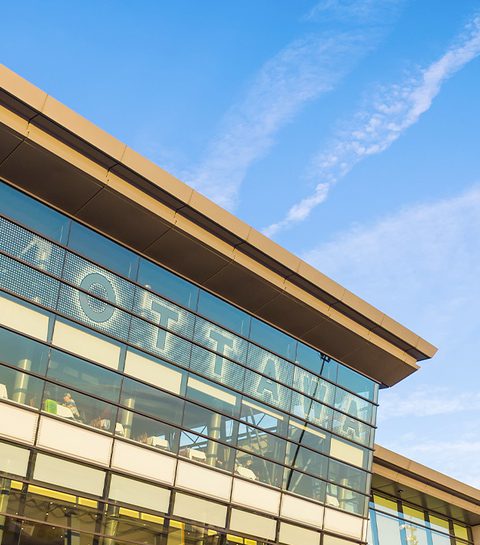2018 Environmental Performance


The Ottawa Airport Authority is committed to improving environmental performance and tracks its progress through the following key performance indicators:
STORMWATER QUALITY
De-icing
For safety reasons, aircraft require de-icing during the winter months. The Airport Authority monitors all stormwater property outlets for the presence of glycol and other parameters resulting from de-icing activities. The presence of glycol was observed at two property outlets on six occasions, all related to the same heavy rain events. A stormwater control valve failed and was quickly sealed shut and a biotreatment system was overwhelmed. The valve was replaced during the summer and the biotreatment system was expanded.
2019 Goals
- Continue to monitor the outlets to identify and mitigate issues.
- Continue to monitor operations and modify as necessary to minimize the potential for glycol impact.
- No exceedances to the Glycol Guidelines.
Glycol application (in litres)
2018 only: 4,057,375 *
2016-2017 winter season: 3,275,941
2015-2016 winter season: 2,878,051
2014-2015 winter season: 3,103,433
* Amount based on a calendar year, not a winter season.
Ground Handling
Accidental spills typically occur as a result of human error or equipment malfunction and mostly occur when servicing aircraft. The Airport Authority and operators work to minimize the impact when spills occur. The majority of spills occur on hard surfaces and are cleaned immediately. In 2018, 88 spills were reported and all spills were contained and prevented from entering the environment.
2019 Goals
- Continue to promote employee awareness.
- Continue to promote regular equipment maintenance to reduce the number of spills.
- Ensure no significant environmental impact from spills.
Significant spills (large enough to require being reported to Environment Canada and the Ontario Ministry of the Environment)
2015: 1
2016: 1
2017: 0
2018: 0
AIR QUALITY
In 2016, the Ottawa Airport Authority received Airports Council International (ACI) Carbon Accreditation Program Level 1 - Mapping certification. In 2017, the Authority achieved Level 2 - Reduction certification. A comprehensive Greenhouse Gases (GHG) Management Plan was developed and implemented as a requirement for Level 2 accreditation. In 2018, we retained our Level 2 certification and applied for Level 3 certification. The requirements for Level 3 include the implementation of the GHG Management Plan and the development of a new Stakeholder Management Plan addressing the emissions of all campus tenants.
2019 Goals
- Obtain Level 3 ACI Certification.
- Continue to implement GHG Management Plan.
- Implement Stakeholder Management Plan.
- Reduce GHG emissions as per plan.
CO2 produced (in tonnes)
2015: 5,728 (CO2eq) = 1.230 per 1000 passengers
2016: 5,354 (CO2eq) = 1.129 per 1000 passengers
2017: 4,987 (CO2eq) = 1.022 per 1000 passengers
2018: 5,254 (CO2eq) = 1.018 per 1000 passengers
AIRCRAFT NOISE
The Airport Authority recognizes that aircraft noise may be a nuisance to some members of the community. Noise Abatement Procedures, which are approved by Transport Canada, are in place. As continued development could bring residential development closer to the airport, the Authority also continues to work with the City of Ottawa to discourage non-airport compatible land uses, to minimize disturbance for future residents.
Background
2011 marked the start of a significant, multi-year, summer airside improvement program. Projects included the resurfacing of Runway 04/22 in 2011 and complete rehabilitation of Runway 07/25 in 2012 and Runway 14/32 in 2014, with runway grooving in 2013 and 2015 respectively. A Simplified Short Approach Lighting System with Runway Alignment (SSALR) was installed on Runway 25 in 2017 and on Runway 14 in 2018. These lights provide greater visibility for landing, particularly when visibility is low. Various taxiways and apron areas have also been renewed since 2011.
Because large projects of this nature disrupt commercial aircraft traffic patterns, which can impact the surrounding general public, ensuring awareness in the community is vital. Before each project, the Authority executed comprehensive communications plans in Ottawa-Gatineau, including media outreach and communication with stakeholders, the municipal and federal governments and impacted communities.
In the summer of 2019, we will renew taxiway B. Therefore, the use of Runway 14/32 (north-south) will be increased and may result in increased noise events for people affected by that runway. The Authority logs all aircraft noise complaints and investigates them to monitor for compliance with noise abatement procedures. Information is provided to Transport Canada for enforcement purposes when a flight is observed to have potentially deviated from proper procedure.
2019 Goals
- Continue to monitor and respond to noise complaints, discuss with the local residents, and identify reoccurring issues and solutions, where possible.
- Work with NAV CANADA and the flying community to ensure flights follow published procedures.
WASTE DIVERSION
A waste diversion program has been in place since 2005. Diversion rates, which were first measured in 2006 at 18% have grown to between 25% and 34%. The 2017 waste audit indicated a diversion rate of 28%, excluding the recycling of wood pallets. Including wood pallets, the waste diversion rates rises to roughly 34%.
We are currently in the process of renewing our Master Concession agreements and have established a goal to increase the waste diversion rate to over 60% as part of those agreements.
Future Goal
- Minimum waste diversion rate of 60%.
GENERAL WASTE
2006: 18%
2010: 25%
2017: 28% (excluding wood pallets)
2017: 34% (including wood pallets)
A waste audit was not completed in 2018.
HAZARDOUS WASTE
The Airport Authority recycles hazardous waste whenever possible. In 2018, we continued to recycle hazardous waste.
- Light tubes: 756 m
- Lamp bulbs: 200 kg
- Batteries: 300 kg
- Aerosols: 150 kg
- Waste oil: 6709 L
- Antifreeze: 205L
- Naptha (parts cleaner): 320 L
2019 Goal
- Continue to minimize and recycle hazardous waste.
BUILDING EFFICIENCY
Fuel Use
The Airport Authority’s operational vehicle fleet includes various types of equipment. Fuel consumption varies considerably depending on winter weather. The number of snow events, duration and amount of snow and ice accumulation dictates how frequently vehicles are used each season. To aid in fuel consumption and emissions, the Authority has a "no idling" policy - when not in use, vehicles are to be turned off and plugged in.
Fuel (in litres)
2015: 562,262
2016: 698,257
2017: 641,254
2018: 721, 472
2019 Goal
- Reduce consumption whenever possible by continuing to monitor for new technology that improves efficiency and maintain a proactive maintenance schedule, which enhances the overall efficiency of the fleet.
Electricity
Electricity use has an impact on Scope 2 emissions that are included in the GHG calculations. Consumption varies from year to year based on factors such as the number of passengers and the weather. In 2018, use was calculated at 25.1M kWh.
Electricity (in 100,000 kW/h)
2015: 26.9
2016: 27.8
2017: 27.7
2018: 25.1
2019 Goal
- Reduce consumption whenever possible by continuing to monitor for new technology that improves efficiency and maintain a proactive maintenance schedule, which enhances the overall efficiency of the building’s systems.
Water
Water use varies from year to year based on factors such as the number of passengers and the weather. In 2018, water use for the airport was 83,692 m3.
Water usage (total consumption in m3)
2016: 83,030
2017: 79,483
2018: 83,692
2019 Goal
- Reduce consumption whenever possible by continuing to monitor for new technology that improves efficiency and maintain a proactive maintenance schedule, which enhances the overall efficiency of the building’s systems.
Natural Gas
As with electricity, natural gas has an impact on GHG. Its use varies from year-to-year based on the number of passengers and the weather. In 2018, consumption was calculated at 1.24M m³ per m² of terminal building floor area.
Natural gas (total consumption in m3)
2015: 1,260,840
2016: 1,244,191
2017: 1,178,395
2018: 1,241,535
2019 Goal
- Reduce consumption whenever possible by continuing to monitor for new technology that improves efficiency and maintain a proactive maintenance schedule, which enhances the overall efficiency of the building’s systems.
